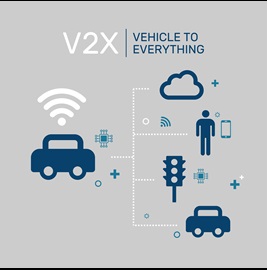Connected and Automated Vehicles
Caltrans is preparing California for future transportation needs by researching and piloting Connected and Automated Vehicles (CAV) technology and other emerging trends in vehicle automation. CAV technology has the potential to save lives, provide greater mobility for all people, improve roadway efficiency, increase California's economic competitiveness, and make our environment and people healthier by:
- Decreasing the number of crashes attributed to human error.
- Transforming the future of how we move people and goods for all including pedestrians, bicyclists, and transit users.
- Providing shared mobility for greater access to transportation, jobs, education, health care, and other critical services.
- Enhancing the benefit of alternative fuel vehicles.
- Improving rideshare and reducing vehicle miles traveled, reducing greenhouse gases, and minimizing the impacts of climate change.
- Integrating CAV infrastructure technologies at signalized intersections to reduce vehicle crashes and improve pedestrian and bicyclist safety, contributing to the Toward Zero Deaths goal.
What are Connected and Automated Vehicles?
Connected and Automated Vehicles (CAV) leverages both Connected Vehicle (CV) and Automated Vehicle (AV) technologies by communicating with nearby vehicles and infrastructure thus providing vehicle automation to make driving decisions.
Connected Vehicles (CV) are "connected" to receive and send alerts by communicating in the following ways:
| Vehicle-to-Vehicle (V2V) | Information on speed, location, and heading. |  |
| Vehicle-to-Infrastructure (V2I) | Information on signal timing, work zones, crashes, congestion, and weather conditions. | |
| Vehicle-to-Pedestrian (V2P) | Information between vehicles and non-motorized crosswalks and bicyclists. | |
| Vehicle-to-Everything (V2N to V2E) | Data is transmitted to the Transportation Management Center (TMC) for analysis, including demand management, travel times, and incident response. |
Automated Vehicles (AV) are driverless or self-driving vehicles that are artificial intelligence or computer-driven and do not require a human to operate the vehicle safely. Most newer cars today have some automation, usually Level 1 - Driver Assistance or Level 2 - Partial Driver Automation. The below table describes the definition of six levels of driving automation by the Society of Automotive Engineers (SAE) J3016 Standards.
|
0 |
1 | 2 | 3 | 4 | 5 |
|
No Driving Automation Zero Autonomy. The driver performs all driving tasks. |
Driver Assistance The driver controls the vehicle, but some driver-assist features may be included in the vehicle design. |
Partial Driving Automation The vehicle has combined automated functions, like acceleration and steering, but the driver must always remain engaged with the driving task and monitor the environment. |
Conditional Driver Automation A driver is a necessity but is not required to monitor the environment. The driver must always be ready to take control of the vehicle with notice. |
High Driving Automation The vehicle is capable of performing all driving functions under certain conditions. The driver may have the option to control the vehicle. |
Full Driving Automation The vehicle is capable of performing all driving functions under all conditions. The driver may have the option to control the vehicle. |

